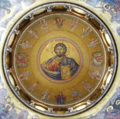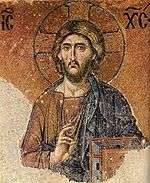Protestant Eastern Christianity
The term Protestant Eastern Christianity (or Reformed Eastern Christianity) encompasses a range of heterogeneous Protestant Christian denominations that developed outside of the Occident from the latter half of the nineteenth century and keeps some or most of all elements of Eastern Christianity. Most of these denominations came into being when existing Protestant Churches adopted reformational variants of Orthodox Christian liturgy and worship; while others are the result of reformations of Orthodox Christian beliefs and practices, inspired by the teachings of Western Protestant missionaries.[1][2][3] Some Protestant Eastern Churches are in communion with similar Western Protestant Churches.[1][4] However, Protestant Eastern Christianity within itself, does not constitute a single communion. This is due to the diverse polities, practices, liturgies and orientations of the denominations which fall under this category.
| Part of a series on |
| Protestantism |
|---|
 |
|
Major branches |
|
Minor branches |
|
Broad-based movements |
|
Related movements |
|
|
| Part of a series on |
| Eastern Christianity |
|---|
 |
|
Main communions
|
|
Eastern liturgical rites |
|
Other topics
|
|
List of Churches
- Armenian Evangelical Church
- Assyrian Evangelical Church
- Assyrian Pentecostal Church
- Believers Eastern Church of India
- Eastern Rite Community in Germany and the Czech Republic
- Evangelical Church of the Augsburg Confession in Slovenia
- Evangelical Orthodox Church
- Kosovo Protestant Evangelical Church
- Mar Thoma Syrian Church
- P'ent'ay movement of Ethiopia and Eritrea
- Russian Evangelical Church[5]
- Society for Eastern Rite Anglicanism
- St. Thomas Evangelical Church of India
- St. Valentine's Fellowship
- Ukrainian Lutheran Church
Ukrainian Lutheran Church
The Byzantine Rite Lutheranism refers to Lutheran Churches, such as those of Ukraine and Slovenia, that use a form of the Byzantine Rite as their liturgy.[6] It is unique in that it is based on the Eastern Christian rite used by the Eastern Orthodox Church, while incorporating theology from the Divine Service contained in the Formula Missae, the base texts for Lutheran liturgies in the West.[3]
Mar Thoma Syrian Church
The Mar Thoma church has its origins in a reformation movement in the Malankara Church, in the latter half of the nineteenth century. India was part of the British Empire at the time and the Malankara Church with its Oriental Orthodox traditions, under the Syriac Orthodox Patriarchate of Antioch. Concurrently, Anglican missionaries from England arrived in South India on a help mission for the Malankara Church. They were tutors and professors at the Church's seminary and made the Bible available in Malayalam. Inspired by the teachings of the missionaries and imbibing the ideas of the Protestant Reformation from them, a few priests under the leadership of Abraham Malpan initiated a reformation based on the Bible. Abraham Malpan also managed to get his nephew Deacon Mathew, ordained as bishop Mathews Mar Athanasius, by the Patriarch of Antioch. But many opposed the reforms. The groups for and against reforms engaged in court litigations for the Church and its properties. These ended in 1889, through a verdict favoring the Patriarchal faction. Subsequently, the reformed faction became an independent church. They use a reformed variant of the Liturgy of Saint James, with many parts in the local vernacular. The Mar Thoma church is in full communion with the Anglican Communion and maintains friendly relations with many other churches.[7][8]
Saint Thomas Evangelical Church of India
The St. Thomas Evangelical Church of India (STECI) is an Evangelical, Episcopal denomination based in Kerala, India. It derives from a schism in the Malankara Mar Thoma Syrian Church in 1961, and traces its ancestry before then back almost 2,000 years. STECI holds that the Bible is the inspired, inerrant and infallible Word of God. Adherents believe that all that is necessary for salvation and living in righteousness is given in the Bible. The church is engaged in active evangelism. The headquarters of this church is at Tiruvalla, a town in the state of Kerala which is the part of South India.[9]
Believers Eastern Church
Believers Eastern Church (formerly Believers Church) is a Christian denomination with roots in Pentecostalism, based in Kerala, India. It exists as a part of the Gospel for Asia.[10][11] In 2003, this church acquired episcopacy, by getting Indian Anglican bishops ordain its founder K. P. Yohannan, as a bishop. Henceforth this denomination adopted several elements of Eastern Christian worship and practices like usage of anointed holy oils, yet keeping the principle of sola scriptura.[12] Its name was officially changed to Believers Eastern Church in 2017, so as to "better express its roots in the ancient and orthodox faith".[13]
Eastern Rite Anglicanism
The Society for Eastern Rite Anglicanism (SERA) is an organization working to promote and sustain a movement towards an established Eastern Rite in the Anglican Communion. Established in 2013, it formulated an Anglo-Orthodox Divine Liturgy. It is based on the Divine Liturgy of Saint John Chrysostom and is used by the society.[14][15]
Assyrian Evangelical Church
The Assyrian Evangelical Church is a Middle Eastern Church which attained ecclesiastical independence from the Presbyterian mission in Iran, in 1870.[16] Its membership comprise mostly of Eastern Aramaic speaking ethnic Assyrians who were originally part of the Assyrian Church of the East and its offshoots or the Syriac Orthodox Church. They, like other Assyrian Christians are sometimes targets of persecution by hostile governments and neighbors.[17][18]
Assyrian Pentecostal Church
The Assyrian Pentecostal Church is a pentecostal Christian denomination which originated in the 1940s among the Assyrian people of Iran and spread among ethnic Assyrians in Iraq, Turkey and Syria.[19][20] They are native speakers of the Assyrian Neo-Aramaic language and use it as their liturgical language too.[21] They also use the Syriac Aramaic Bible.[22] Most of its members were originally part of the Assyrian Church of the East and its offshoots or the Syriac Orthodox Church.[23] This denomination is affiliated to the Assemblies of God Church.[24] There has been reported instances of persecution against them as well.[25]
P'ent'ay (Evangelical) Churches in Ethiopia and Eritrea
The P'ent'ay is an Amharic and Tigrinya language term for evangelical Christians in Ethiopia and Eritrea. This movement have been influenced by the mainstream Orthodox Christianity of these countries as well as Pentecostalism. As Protestantism is relatively new in Ethiopia, most P'ent'ay are ex-Orthodox Christians.[26][27] Many of these groups describe their religious practices as culturally Orthodox, but Protestant by doctrine.[28] The P'ent'ay denominations may constitute as much as 19% of the population of Ethiopia,[29] while being a small minority in Eritrea.[30]
Hybridizing Western Evangelicalism with Eastern Byzantine traditions
The Evangelical Orthodox Church, is a Christian denomination which blends Evangelical Protestantism with features of Eastern Orthodoxy. It started off in 1973, as a network of house churches established by Campus Crusade for Christ missionaries, in the United States. The founders Peter E. Gillquist, Jack Sparks, Jon Braun, and J.R. Ballew wanted to restore Christianity to its primitive form, based on the writings of the early Church Fathers. So, they stood in a circle and self-ordained each other, creating an entity called the New Covenant Apostolic Order (NCAO). Their own construings of Church history led to the adoption of a somewhat liturgical form of worship and induced a need for apostolic succession. In 1977, the first contact with the Eastern Orthodox Church was initiated through Orthodox seminarian Fr. John Bartke. In 1979, the Evangelical Orthodox Church (EOC) was organized. The EOC pursued various avenues to obtain episcopacy, including a visit to the Patriarch of Constantinople, but to no avail. At last, they met Patriarch Ignatius IV of Antioch, during his historic visit to Los Angeles which proved successful. This meeting was arranged by Fr. John Bartke, who later served as the primary intermediary between the EOC and the Antiochian Orthodox Archdiocese and also hosted the initial set of chrismations and ordinations for the EOC at St. Michael's Church in Van Nuys, California. Unable to completely reconcile Evangelicalism and Orthodoxy, many EOC members formally joined the Antiochian Orthodox Christian Archdiocese of North America, in 1987. Some others, joined the Orthodox Church in America. The rest remained independent and continues as the Evangelical Orthodox Church.[31][32][33][34]
Laedstadianism (Apostolic Lutheranism)
In the far north of the Scandinavian peninsula are the Sámi people, some of which practice a form of Lutheranism called Apostolic Lutheranism, or Laestadianism due to the efforts of Lars Levi Laestadius. However, others are Orthodox in religion. Some Apostolic Lutherans consider their movement as part of an unbroken line down from the Apostles. In Russia, Laestadians of Lutheran background cooperate with the Ingrian church, but since Laestadianism is an interdenominational movement, some are Eastern Orthodox. Eastern Orthodox Laestadians are known as Ushkovayzet (article is in Russian).[35]
See also
- Zoë movement, sometimes regarded as a crypto-Protestant movement in the Greek church.
References
- Rodriguez, Manuel Fernandez. "Eastern Protestant and Reformed Churches "a historical and ecumenical look"".
- Werff, Lyle L. Vander (1977). Christian Mission to Muslims: The Record : Anglican and Reformed Approaches in India and the Near East, 1800-1938. William Carey Library. ISBN 978-0-87808-320-6.
- Bebis, Fr. Vassilios. "The Divine Liturgy of Saint John Chrysostom, used by the Ukrainian Lutheran Church, and its missing elements".
- "Heritage – Malankara Mar Thoma Syrian Church".
- Alexy II, ed. (2008). "Евангельские христиане" [Evangelical christians]. Православная энциклопедия [Orthodox Encyclopedia] (in Russian). 17. Москва: Церковно-научный центр "Православная энциклопедия". pp. 40–44. ISBN 978-5-89572-030-1.
- Hämmerli, Maria; Mayer, Jean-François (23 May 2016). Orthodox Identities in Western Europe: Migration, Settlement and Innovation. Routledge. p. 13. ISBN 9781317084914.
- "Heritage – Malankara Mar Thoma Syrian Church".
- Neill, Stephen (2002). A History of Christianity in India: 1707-1858. Cambridge University Press. p. 250. ISBN 0521893321. Retrieved 19 February 2016.
- "Church History". St. Thomas Evangelical Church of India (steci) is an episcopal Church.
- The South Indian Pentecostal movement in the twentieth century. William B. Eerdmans Pub. Co. 2008-06-06. p. 54. ISBN 9780802827340.
- "Believers Eastern Church". www.gfaau.org.
- "K.P. Yohannan Blesses and Consecrates Holy Oils for Believers Eastern Church".
- "Believers Eastern Church".
- "The Birth of a Movement: Society for Eastern Rite Anglicanism. - Free Online Library". www.thefreelibrary.com.
- "Anglo-Orthodox Divine Liturgy - Society for Eastern Rite Anglicanism (SERA)".
- Vander Werff, Lyle L. (1977). Christian mission to Muslims: the record : Anglican and Reformed approaches in India and the Near East, 1800-1938. The William Carey Library series on Islamic studies. William Carey Library. pp. 366. ISBN 978-0-87808-320-6.
- "Who are the Assyrians? 10 Things to Know about their History & Faith". Christianity.com.
- "UNPO: Assyria: Church Raided by Iranian Authorities". unpo.org.
- Iran Almanac and Book of Facts (9 ed.). Echo of Iran. 1970.
- Religion and nation : Iranian local and transnational networks in Britain. Berghahn Books. 2004. p. 199. ISBN 1571815767.
- "Wayback Machine". 14 February 2012. Archived from the original on 14 February 2012.
- "Aramaic Bible Translation". 31 May 2015. Archived from the original on 31 May 2015.
- "Who are the Assyrians? 10 Things to Know about their History & Faith". Christianity.com.
- "Haik's Impact Upon Church History". Archived from the original on 2005-01-02.
- "Wife of Iranian Pentecostal Leader Sentenced to 5 Years in Prison After Praying With Christians". www.christianpost.com.
- "Ethiopian Culture - Religion". Cultural Atlas.
- Eshete, Tibebe (2009). The evangelical movement in Ethiopia : resistance and resilience. Baylor University Press. ISBN 9781602580022.
- "Pentecostal and Charismatic Christianity in Ethiopia: A Historical Introduction to a Largely Unexplored Movement". ResearchGate.
- Baker, Stephanie (18 October 2012). "Religion In Ethiopia". ethiogrio.com.
- "ERITREA" (PDF).
- Lloyd R. Thompson, “A Critical Analysis of the Evangelical Orthodox Church (New Covenant Apostolic Order)” (Ph.D. diss., Yale Divinity School, 1979), 20.
- Ruth Stiling, “An Examination of the Evangelical Orthodox Church” (M.A. thesis, Dallas Theological Seminary, May 1980), 17-18.
- Steve Barth, “Development of Evangelical Church Traced: Twelve Years of Theology Change Moves Away from Anti-Authority,” Daily Nexus (November 13, 1979): 2.
- D. Oliver Herbel, Turning to Tradition: Converts and the Making of an American Orthodox Church (Oxford University Press, 2014), 104-117.
- Karelian religious movement Uskhovayzet
